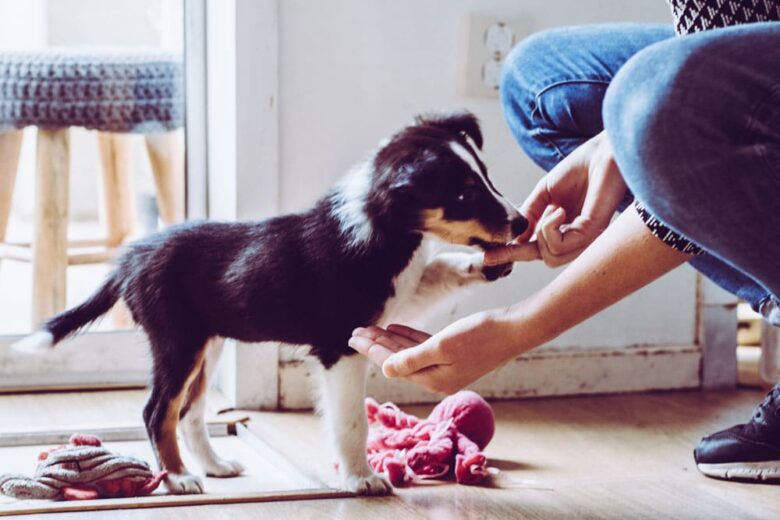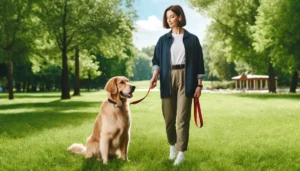Dog owners need to train their puppies if they want their furry friend to grow into a well-behaved and friendly dog. Training a puppy can be fun and difficult, and you need to be patient, consistent, and understanding throughout the process. This comprehensive guide to puppy training methods will give you the information and tools you need to manage this important time in your dog’s life.
1. Lay the Foundation:
Building a strong, positive bond with your puppy is the most important part of training. This connection is the basis of all training. It makes talking to each other easier and makes training fun for both of you. Start by giving each other lots of love and spending quality time playing together.
2. Training at Home:
The first thing most puppy owners do is train their dog to go to the outdoor bathroom. Consistency and attention are the keys to effective indoor training. Set fixed times for eating and going to the toilet. For example, take your puppy outside in the morning, after meals and before bedtime. When your puppy goes outside to the bathroom, praise and reward him immediately. This will help them keep doing what you want them to do. Accidents will happen. If they do, clean up after yourself, stay out of trouble, and maintain a positive attitude.
3. Crate Training:
A crate is a great way to teach your puppy to go to the toilet outside, and it also provides him with a safe place to be alone. Gradually introduce your dog to the crate and add blankets and toys to make it comfortable and fun. Never force your puppy into the playpen. Instead, send them off with treats and compliments. The crate should always be a happy place and should not be used to punish the dog. Crate training your dog can also help prevent unwanted behavior and concerns.
4. Basic Commands:
For your safety and that of your puppy, it is important to teach your puppy basic commands such as’sit’,’stay’, ‘come’ and ‘down’. Use positive feedback by giving rewards, praising or playing as a reward for good behavior. The training is short and fun. Focus on one order at a time until you master it. It’s important to be patient and consistent, and repeating these instructions over and over will help them stick to them.
5. Socialization:
Proper training is important to ensure your dog grows into a happy, confident adult. As part of socialization, introduce your puppy to new people, animals, places and things in a controlled and proper manner. This exposure helps reduce anxiety and aggression, making people friendlier and more relaxed in different environments. Start socializing your puppy early, but make sure he has had all the shots before taking him out in public with other dogs.
6. Biting and Chewing:
Puppies use their lips to explore the world around them, which causes them to bite and chew. Teaching a dog not to bite is important to prevent future problems. When you are playing and your puppy bites too hard, shout loudly to let him know it hurts. Then stop playing immediately. To prevent them from chewing on furniture or personal items, it is best to direct their chewing to appropriate toys and give them plenty to chew.
7. Leash Training:
For their safety and when traveling to public places, it is important to teach your baby how to walk on a leash as early as possible. Start with a short, active activity in the interior and gradually extend it to the outdoor areas. To help people walk smoothly without pulling, you can use treats and praise. Remember, the world is a big and exciting place for your puppy, so be patient as he learns to walk on a leash.
8. Stay Steady and Patient:
Consistency and patience are most important when teaching a puppy. Dogs behave best when they know what to expect. Consistent orders, rewards and schedules help you achieve the desired behavior. Know that training takes time and has its ups and downs. Maintain a cheerful, patient attitude and celebrate your victories, no matter how small.
9. Seek Professional Help:
If you’re having trouble teaching your puppy, don’t be afraid to seek help from a professional. Professional dog trainers and puppy classes can provide you with personalized tips and strategies to help you solve problems and give your puppy a strong training foundation.
10. Summary:
You must be willing to put in a lot of time, be patient and enjoy training dogs. You can help your puppies develop into well-behaved adult dogs by building a strong bond with them, being clear about your expectations for them, and using positive feedback. Remember that training isn’t just about teaching your puppy how to behave; it’s also about creating a strong, lasting bond between you and your puppy. Training your puppy can be fun and rewarding if you do it right. You will feel good watching your puppy learn and grow.
FAQs:
Q. What is the best age to start training a puppy?
The best age to start training a puppy is as soon as he comes into your home, usually around 8 weeks of age. Early training and socialization are crucial for producing a well-behaved adult dog. Start with simple commands and gradually introduce more complex training as they grow.
Q. How often should I train my puppy and for how long?
Short, frequent training is best for puppies. Try to perform several 5- to 10-minute sessions throughout the day. Puppies have short attention spans, so keeping sessions short will keep them focused and make learning more effective.
Q. What basic commands should my puppy learn?
Some basic commands that every puppy should learn are ‘sit’,’stay’, ‘come’, ‘down’ and ‘go away’. These basic commands will not only help manage your puppy’s behavior but also keep him safe in potentially dangerous situations.
Q. How can I potty train my puppy effectively?
Effective toilet training involves establishing consistent habits, walking your puppy regularly, especially after meals and naps, and praising the dog for defecating outside. Be patient and avoid punishment for indoor accidents; instead, focus on positive reinforcement for successful outdoor toileting.
Q. My puppy bites. How can I stop this behavior?
Biting is a normal part of puppy development, but it’s important to teach them bite inhibition. When your puppy bites too hard, let out a “squeak” or a firm “no” to indicate that the behavior is unacceptable, then turn his attention to the toy. The consistency of this approach can teach your puppy to bite less forcefully and eventually stop biting altogether.


